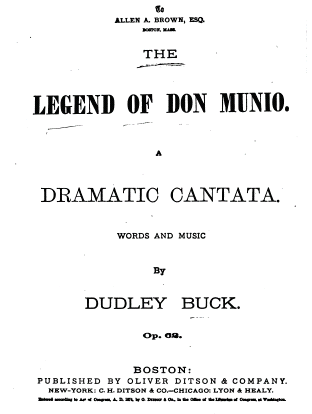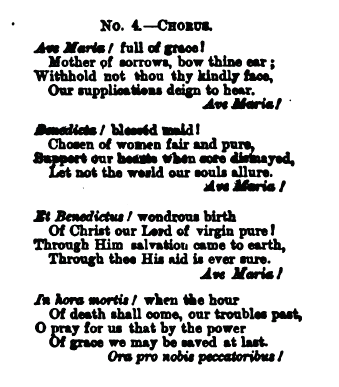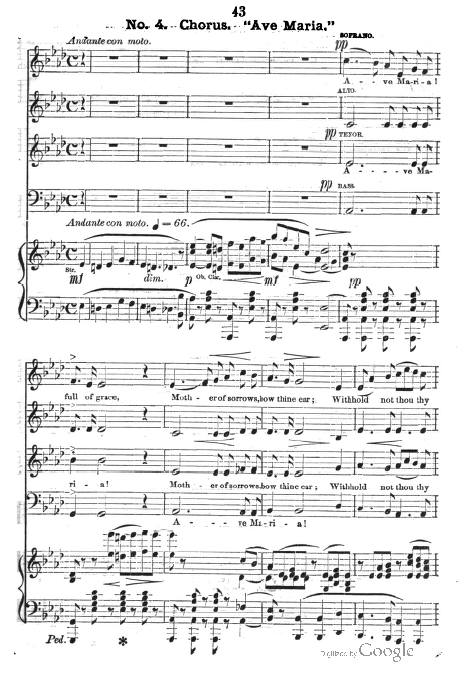Ave Maria SATB chorus + acc. in Op.62 "The legend of
Don Munio"
Composer: Dudley Buck (1839-1909), 1874

 |
X |
X |
X |
X |
|
Dudley |
|
Buck |
|
1839 |
1909 |
|
1874 |
|
op. 62 |
Ave Maria |
SATB |
piano |
GoogleBooks The legend of Don Munio: Part1 No.4 |
|
X |
X |
X |
X |
X |
|
Dudley |
|
Buck |
|
1839 |
1909 |
|
1895c |
|
Op.67/1 |
Ave Maria |
solo high voice |
|
in 1895 + 1910 |

Op.62 "The legend of Don Munio" is available
online through
GoogleBooks

| Recording: not available |
|
| Lyrics: (S) |
|
A-_ ve Ma-ri-a, full of grace,
Mo-_ ther of sor-rows,
bow thine ear,
With-hold _ not thou _ _
thy kind-ly face.
Our sup-pli-ca-tions deign to hear,
A-_ _ _ _ _ _ _ _ ve, A-ve Ma-ri-_ a.
Be-ne-dic-ta, bles-sed Maid,
Cho-sen of wo-men,
fair and pure,
Sup-port our hearts
when sore dis-mayed,
Let not the world our souls al-lure.
A-_ ve, A-_ _ ve Ma-ri-_ a.
|
Et be-ne-dic-_ tus! _
won-drous birth of Christ,
our Lord, of vir-gin pure,
Through Him, sal-ca-tion came to earth,
thro' thee, His aid is ev-er sure.
A-_ _ _ _ _ _ _ _ ve, A-ve Ma-ri-_ a.
When the hour of death shall come,
Our troub-les past,
O pray for us, that by the pow-er of grace,
we may be saved at last _
O-_ ra! O-_ _ ra pro no-bis pec-ca-to-ri-bus,
O-_ ra! O-_ ra pro no-_ bis. O-_ ra pro no-bis, _
pec-_ ca-to-ri-bus, pec-ca-to-ri-bus,
pec-ca-to-ri-bus. O-ra! O-_ ra!
|
| |
|
 |

|
| Score: (9pp.) |
|

|

A
biographical dictionary of musicians (ed.
Theodore Baker)
G. Schirmer, 1905 - Biography & Autobiography - 695 pages |

 |
Buck Dudley noted organist composer and teacher
b Hartford, Conn Mar 10 1839
Pupil of WJ Bab cock pf later at LeipzigCons 1S58 9 of Plaidy faf SfcJ &
Hauptmann com p and J Rietz instrumentation also studied under Rietz and
Johann Schneider organ at Ores den and thereafter spent a year 1 861 2 for
study in Paris Returning to America he became 1862 organist of the Park Ch
Hartford later of St James Chicago in 1S72 of St Paul's Boston where he was
also organist to the Music Hall Association In 1875 he was the organist of
the Cincinnati May Festival then at New York asst conductor of Th Thomas
Central Park Garden Concerts and org of St Anne's Brooklyn in the same year
becoming the org of Holy Trinity Ch Brooklyn and director of the Apollo Club
He was one of the first American composers to achieve general recognition
his church music and numerous cantatas sacred and secular are deservedly
popular Works The comic opera Dcseret 1880 symphonic overture Marmion 18S0 a
Can zonetta and Bolero f vln and orch Organ music Grand Sonata in 10 f op 22
Sonata No 2 in G min op 77 Triumphal March op 26 Impromptu and Pastorale op
27 Bon do Caprice op 35 Idyllc At Evening op 52 Four Tone pictures various
transcriptions and sets of variations also 18 Pedal phrasing Studies op 28 2
books and Illustrations in Choir accompaniment with Hints on Registration a
valuable handbook for organists and students Pp MUSIC Midsummer Fancies
Winter Pictures Rondo Caprice Scherzo Caprice Cantatas a for male chorus
Chorus of Spirits and Hours from Prometheus Unbound King Olaf's Christmas
The Nun of A idaros Voyage of Columbus Paul Revere 5 Ride b for mixed chorus
Centennial Meditation of Columbia Hymn to Music Legend of Don Munio The
Golden Legend The Light of Asia Easter Morning The 46th Psalm The Christian
Year a series of 5 cantatas 1 The Triumph of David 2 The Coming of the King
3 The Song of the A ight 4 The Story of the Cross 5 Christ the Victor etc
Furthermore a great variety of excellent church music hymns anthems 3 Latin
offertories Glorias Jubilates Te Deums 3 Benedic anima 4 Benedictus 3 Bonum
est 3 Cantate Domino etc B has also publ The Organist's Repertoire with AP
Warren The Influence of the Organ in History 1882 and a Dictionary of
Musical Terms |
 
Please notify us of any broken/defective links

Page last modified:
November 04, 2011
Return to my homepage:
www.avemariasongs.org

|
![]()